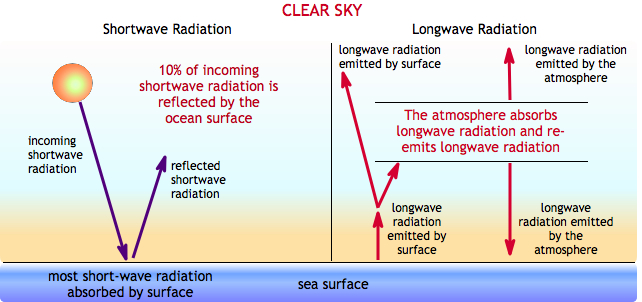
|

|


Clouds and Climate
How do clouds affect the temperature you feel at the Earth's surface? Aside from producing precipitation, clouds have a profound effect on our climate. If you consider the overall effect of all clouds on the surface temperature, they have a cooling effect because they block incoming solar radiation. However, the effect of an individual cloud depends on many factors such as its height, thickness, location, and whether it is day or night. Let's explore why this is true. To understand the effect of clouds on climate, we have to understand some basic concepts about radiation and the energy balance at the Earth's surface. The temperature that we feel on Earth's surface is due to a balance between the incoming solar radiation and the emitted radiation from our planet. Particles in the atmosphere also emit and absorb radiation, including cloud droplets. Cloud droplets are excellent absorbers and emitters of infrared radiation (the radiation emitted by Earth), but they only reflect solar radiation. Since most of the planet is covered by oceans, let's consider how clouds affect sea surface temperatures. The Earth is receiving energy from the Sun and emitting radiation depending on its temperature. On average, 10% of the incoming solar radiation is reflected by the ocean surface. The other 90% warms the surface, and then the Earth emits radiation in the longwave part of the spectrum. Some of this longwave radiation escapes to space, but some is absorbed and re-emitted by certain gases in the atmosphere. These gases are the greenhouse gases like methane, water vapor, and carbon dioxide.
 Next page
->
How do clouds affect the temperature continued
Links and resources
Next page
->
How do clouds affect the temperature continued
Links and resources
How do clouds affect the temperature you feel at the Earth's surface? Aside from producing precipitation, clouds have a profound effect on our climate. If you consider the overall effect of all clouds on the surface temperature, they have a cooling effect because they block incoming solar radiation. However, the effect of an individual cloud depends on many factors such as its height, thickness, location, and whether it is day or night. Let's explore why this is true. To understand the effect of clouds on climate, we have to understand some basic concepts about radiation and the energy balance at the Earth's surface. The temperature that we feel on Earth's surface is due to a balance between the incoming solar radiation and the emitted radiation from our planet. Particles in the atmosphere also emit and absorb radiation, including cloud droplets. Cloud droplets are excellent absorbers and emitters of infrared radiation (the radiation emitted by Earth), but they only reflect solar radiation. Since most of the planet is covered by oceans, let's consider how clouds affect sea surface temperatures. The Earth is receiving energy from the Sun and emitting radiation depending on its temperature. On average, 10% of the incoming solar radiation is reflected by the ocean surface. The other 90% warms the surface, and then the Earth emits radiation in the longwave part of the spectrum. Some of this longwave radiation escapes to space, but some is absorbed and re-emitted by certain gases in the atmosphere. These gases are the greenhouse gases like methane, water vapor, and carbon dioxide.

